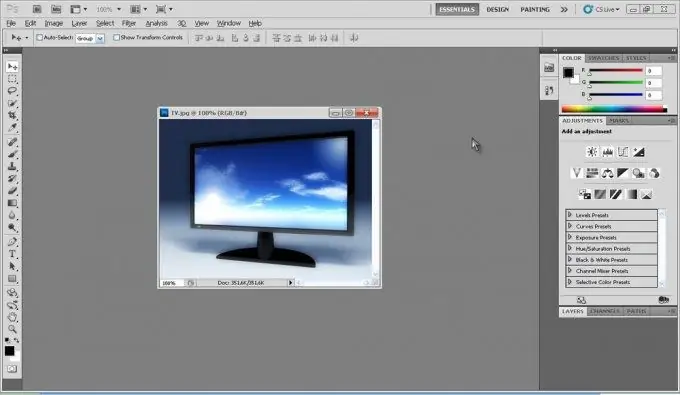When the need arises to make the background of a photo transparent, people most often turn to Photoshop. And not in vain, because for more than 25 years of its development, the program has collected and improved an impressive number of tools and techniques to accomplish this task.

Instructions
Step 1
First you need to decide on the basic principles of the program and the properties of the images themselves. A photo file is a pixel art, essentially a collection of colored dots, like a mosaic with very little grain. The program does not highlight any significant objects within the photo. Only recently, elements of artificial intelligence have been introduced into Photoshop to analyze the contents of a picture, in the manner of human consciousness. To solve the problem, these elements are not directly applied, therefore they can be omitted.
The basis of Photoshop's work is its ability to work with layers. An analogy of layers in Photoshop will be a neatly folded stack of sheets, where some sheets will be opaque, others will be transparent in some places, and in others there will be holes. Thus, when looking at the stack from above, we will get a combined image from all layers, where the lower sheets will be visible through the transparency areas or holes.
Step 2
The photo is loaded into Photoshop as a single layer, completely opaque. The program has a special panel where you can see the entire stack of layers. It is called and hidden by pressing the F7 key, or through the Window-Layers menu (Windows-Layers). In the layers panel, the photo is displayed as Background. This is a special bottom layer that has some limitations. It is unnecessary and unproductive to work on it, because it is always better to have the original image at hand. Therefore, the first thing you need to do is right-click on this layer and select Duplicate Layer, give the new layer a name and click OK. Now you can hide the background layer so that it does not interfere by clicking on the eye next to the layer preview.

Step 3
In order to work with a layer, you must first select it. You just need to click on the desired layer in the Layers panel. It will be highlighted in a special way, so you can always tell which layer is currently working. Now you can make the background transparent. You always need to start by highlighting the part of the photo that you want to leave visible. If the object has clear geometric boundaries, the Polygonal Lasso Tool is best. With this tool, you need to click on the corners of the object along its borders, creating a closed selection frame from straight lines. Everything that is inside the selection border will be considered an object of processing for Photoshop tools, everything that remains outside the frame will be ignored. Now you can copy the selected area from one layer to another using the Ctrl + J command or through the context menu with the right mouse button “Layer via copy”. A new layer with the copied area will appear in the layers panel. Its contents can be viewed by turning off the viewer of the lower layer, and leaving only the new view. The area around the object on this new layer will be filled with a checkerboard pattern of white and gray squares. This is how Photoshop shows the area of transparency. Now the photo can be saved in.
Step 4
Copying or Cutting to a New Layer is the easiest way to remove the background, but also not very flexible, because to fix mistakes you need to start all over again. There is also another way. At the very bottom of the layers panel, there are a row of buttons. If you click on the third from the right, which is called "Add layer mask" (Add layer mask), then a white rectangle will be added to the selected layer in the Layers panel. This is a layer transparency mask, it determines what is visible, what is invisible and what is semi-transparent in the layer. It works as follows: everything that is painted over with black on the mask is invisible; that which is painted over with white is visible completely, and everything that is painted over with a shade of gray will be partially visible. Moreover, the lighter the gray, the more transparent the area will be, and the darker, the more opaque everything painted over will be. You can paint on a mask using any Photoshop painting tools, but most often they paint with a brush (brush) of black and white colors. If you create a mask when something is already selected on the layer, then the selection area on the mask will be filled with white, and everything else - with black. By clicking on the mask icon in the Layers panel, you can correct selection errors with a white / black brush, which gives additional flexibility in work. Another advantage is that the selection will not be reset every time you decide to select something else in the photo, but will remain on the mask. Also, the mask does not really remove or recolor anything, it only hides, therefore all changes are completely reversible.
Step 5
They usually work as follows. Using the selection tool, make a rough stencil of an object from a photograph, and then refine it manually using a mask, adjusting the edges with a small brush with a hardness of 95%. Additional options for refining the mask can be obtained by selecting the mask in the layers panel and opening the Properties panel from the Windows menu. In the properties panel of the mask, you can set the general transparency, blur the edges, and also open additional options by clicking on the Selection and Mask button. In the window that opens, you can set a "smart radius" to refine the boundaries automatically, which helps a lot in selecting the hair. Feathering, smoothness of borders and their contrast are also adjusted, you can move the border of the selection outward or inward, and set up how to display all these changes.
Simple problems with contrasting objects of the correct shape are not difficult to solve, and even a beginner can cope with them. When it comes to more complex shapes or special shooting conditions, selection turns into a difficult task and requires both additional knowledge of the program and practice.






